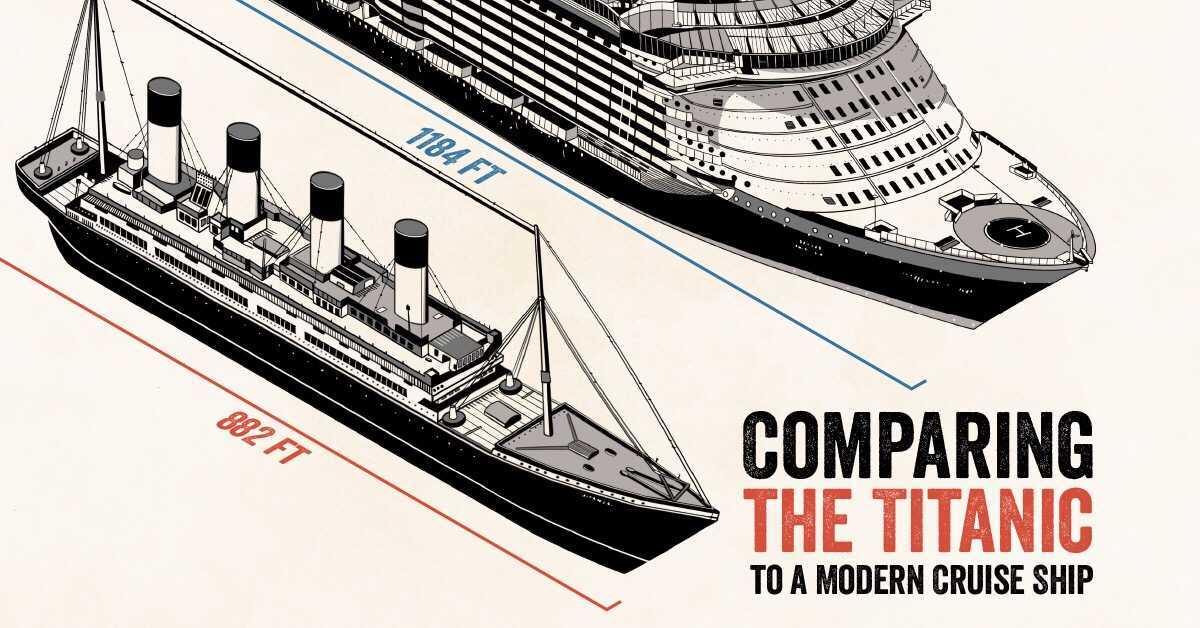Table Of Content
- Titanic vs a Modern Cruise Ship Fleet – Comparison with Photos!
- thought on “Titanic Vs Modern Cruise Ships (Size Comparison)”
- A Competitive Industry Benefitting Travelers
- Icon of the Seas vs. Titanic: A Cruise Ship and an Ocean Liner
- What is the size difference between the Titanic and modern cruise ships?

Despite its fame and the luxury it offered passengers, the Titanic wasn’t actually a cruise ship. Instead, it was an ocean liner, a type of ship designed for transporting people across the ocean from one point to another. Ocean liners usually have a stronger build and a deeper hull to handle rough sea conditions. They typically operate on fixed routes, like the transatlantic crossings between Europe and North America. Additionally, ocean liners are faster than cruise ships, with average speeds of about knots (29 mph/47 kph). There is no doubt that modern cruise ships offer a level of luxury that far surpasses what was available on the Titanic.
Titanic vs a Modern Cruise Ship Fleet – Comparison with Photos!
Modern-day cruise ships, such as the Oasis-class line of cruise ships, are about a third longer and about twice the width of the Titanic. Modern cruise ships have multiple fire prevention and suppression systems in place, including sprinkler systems, smoke detectors, and fire alarms, to help prevent and contain fires on board. Second-class passengers had access to a spacious outdoor promenade, a library, a smoking room, and a dining room, where evening tea and coffee were served. The dining area could seat nearly 2,300 people at once, and a musician would provide entertainment during meals.
thought on “Titanic Vs Modern Cruise Ships (Size Comparison)”
The bulkheads on other ships were extended higher to make the compartments fully watertight. The Titanic had a total of 2240 passengers on board when she sank in the early morning hours of April 15, 1912. The sinking of the Titanic is one of the most famous maritime disasters in history. Even having a look at private accommodations, Icon manages to beat Titanic.
A Competitive Industry Benefitting Travelers
On the other hand, modern cruise ships are built with double-hull technology and multiple watertight compartments that extend up the side of the hull. These features provide better structural integrity and improve the ship’s ability to prevent flooding. You might be wondering how the Titanic, once deemed the “unsinkable” ship, compares to the giant floating resorts we know today as modern cruise ships. When the Titanic embarked on its tragic maiden voyage in 1912, it represented the height of luxury and cutting-edge technology for ocean liners.


One of the most significant advancements in navigation systems is the implementation of satellite technology, specifically GPS (Global Positioning System). Modern cruise ships are equipped with sophisticated GPS systems that allow precise tracking of their locations at all times. This ensures accurate monitoring by both the crew and authorities ashore. In contrast, during the time of the Titanic, navigational aids were limited to methods such as celestial navigation using stars or compass readings. The introduction of GPS has revolutionized maritime navigation by providing real-time location data, enhancing safety measures aboard modern cruises.
Icon of the Seas vs. Titanic: A Cruise Ship and an Ocean Liner
That makes the new ship twice as tall (excluding Titanic’s towering funnels) and over twice as wide, as well as nearly 5.5 times larger volumetrically. If anything, it’s the two vessels’ lengths that are the closest to one another. The Titanic was one of the giant ocean liners of her era, and it had nine decks. At the same time, Modern cruises have more than 10 decks and higher passenger capacity.
Comparing the Titanic to the current Cunard fleet also shows that the Titanic was smaller and lighter than modern Cunard ships. Building methods and materials have also improved greatly since Titanic was built which allows ships to be built bigger and faster. I worked as an officer in the deck department on various types of vessels, including oil and chemical tankers, LPG carriers, and even reefer and TSHD in the early years. Currently employed as Marine Surveyor carrying cargo, draft, bunker, and warranty survey. At that time, the Titanic’s reign as the largest ship afloat became a short one, as was its time in service. It made its maiden voyage on April 10, 1912, and only sailed for a mere five days before the fatal collision that caused it to sink in the North Atlantic Ocean in the early morning of April 15, 1912.
Located on deck 5, just below Central Park, the three-deck-high Royal Promenade is the ship’s mall area. Also, this neighborhood is lined with eight retail shops, three restaurants, and six bars. Ships were refitted for increased safety following the Titanic disaster. Many ships, including the RMS Olympic, had their double bottoms extended up the sides of their hulls to give them double hulls.
Timeline: The World's Biggest Passenger Ships from 1831-Present - Visual Capitalist
Timeline: The World's Biggest Passenger Ships from 1831-Present.
Posted: Fri, 28 May 2021 07:00:00 GMT [source]
Shipbuilding techniques have come a long way since the construction of the Titanic. Today’s cruise ships boast more efficient hull designs that enhance stability and reduce drag, resulting in smoother sailing experiences for passengers. These advancements have been made possible by innovations in naval architecture and computer-aided design (CAD) technologies. One notable improvement is the availability of private bathrooms in most contemporary cruise ship cabins. Unlike the shared facilities on board the Titanic, guests can now enjoy their own personal space without having to wait or share with others. Most of the ships to have launched more recently are a little bigger than the Titanic, so there aren’t a lot still sailing that closely match her for size.
It measured 882 feet long and 46,328 gross registered tons (GRT), which is a measurement that incorporates the ship’s total enclosed volume. Second class rooms accounted for 162 and 262 of these were for third-class passengers. Today's cruise ship averages 1,401 cabins and the Symphony has 2,745 total staterooms. Unlike ocean liners which travel long distances over periods of days, cruise ships don’t usually require fast speeds as they typically travel short distances between ports over the span of days.
Overall the average cruise ship has come a long way in terms of safety, with regulations and standards improving significantly over the years. Modern cruise ships are subject to much more rigorous safety requirements and have taken significant steps to reduce the risk of accidents or other incidents. While there is room for improvement, the industry has made great strides in ensuring that passengers are safe while onboard. One of the most significant changes in cruise ship safety standards has been the requirement for lifeboats.
Modern cruise ships are equipped with satellite phones, Wi-Fi, and data links that enable continuous, worldwide communication. The top speed of this well-known luxury vessel is 30 knots, while the typical cruise ship cruising speed is 18 to 22 knots. There were 162 rooms in the second class, and 262 of these were for third-class travelers. The Symphony has a total of 2,745 staterooms, which is more than the 1,401 cabins that the average cruise ship has today. She is unquestionably smaller when compared to contemporary cruise ships. However, it wasn’t any smaller than what you might have anticipated given the time frame.

No comments:
Post a Comment